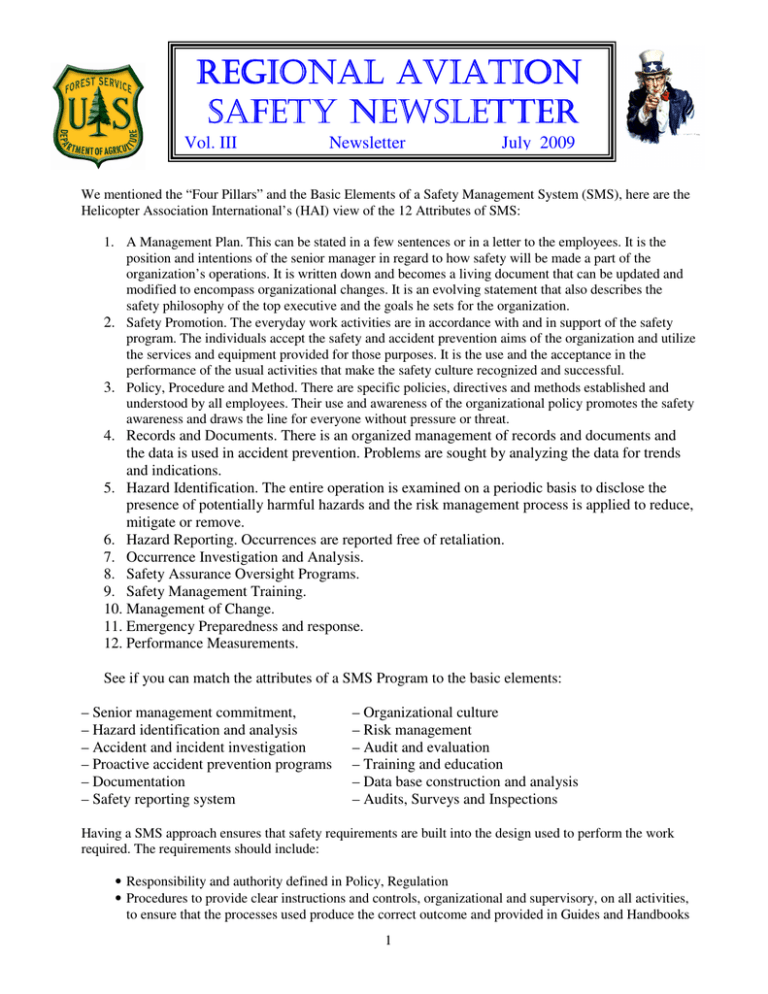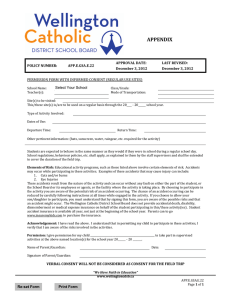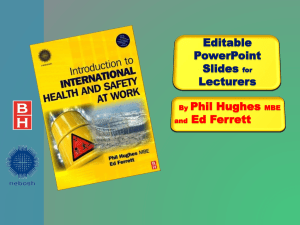REGIONAL AVIATION SAFETY NEWSLETTER
advertisement

REGIONAL AVIATION SAFETY NEWSLETTER Vol. III Newsletter July 2009 We mentioned the “Four Pillars” and the Basic Elements of a Safety Management System (SMS), here are the Helicopter Association International’s (HAI) view of the 12 Attributes of SMS: 1. A Management Plan. This can be stated in a few sentences or in a letter to the employees. It is the position and intentions of the senior manager in regard to how safety will be made a part of the organization’s operations. It is written down and becomes a living document that can be updated and modified to encompass organizational changes. It is an evolving statement that also describes the safety philosophy of the top executive and the goals he sets for the organization. 2. Safety Promotion. The everyday work activities are in accordance with and in support of the safety program. The individuals accept the safety and accident prevention aims of the organization and utilize the services and equipment provided for those purposes. It is the use and the acceptance in the performance of the usual activities that make the safety culture recognized and successful. 3. Policy, Procedure and Method. There are specific policies, directives and methods established and understood by all employees. Their use and awareness of the organizational policy promotes the safety awareness and draws the line for everyone without pressure or threat. 4. Records and Documents. There is an organized management of records and documents and the data is used in accident prevention. Problems are sought by analyzing the data for trends and indications. 5. Hazard Identification. The entire operation is examined on a periodic basis to disclose the presence of potentially harmful hazards and the risk management process is applied to reduce, mitigate or remove. 6. Hazard Reporting. Occurrences are reported free of retaliation. 7. Occurrence Investigation and Analysis. 8. Safety Assurance Oversight Programs. 9. Safety Management Training. 10. Management of Change. 11. Emergency Preparedness and response. 12. Performance Measurements. See if you can match the attributes of a SMS Program to the basic elements: – Senior management commitment, – Hazard identification and analysis – Accident and incident investigation – Proactive accident prevention programs – Documentation – Safety reporting system – Organizational culture – Risk management – Audit and evaluation – Training and education – Data base construction and analysis – Audits, Surveys and Inspections Having a SMS approach ensures that safety requirements are built into the design used to perform the work required. The requirements should include: • Responsibility and authority defined in Policy, Regulation • Procedures to provide clear instructions and controls, organizational and supervisory, on all activities, to ensure that the processes used produce the correct outcome and provided in Guides and Handbooks 1 One consideration of Aviation Safety is the subtle shift in accident investigation; moving from a concentrated focus on the performances of individual ‘frontline’ operators, such as pilots, air traffic controllers and maintenance personnel, to consideration of the performance of the system as a whole. These frontline operators always have a part to play in safety and are, unfortunately, usually playing a part in accidents. Aviation accident investigation has the goal of prevention and there are many entities searching for ways to improve aviation safety using accident statistics and other reported information. But, several facts are already known- For almost every aviation accident or incident, civil or military, the subsequent investigation has shown that: · The main contributing factors were present before it happened · In some cases they were common knowledge · They had been formally documented · Many people were not surprised by what happened In all cases, they could have, and should have, been identified and fixed before the accident or incident. This is not looking at accidents with the benefit of hindsight- It is simply a fact. The absence of an integrated Safety Management System in some of the organizations directly involved was a key factor in explaining why critical safety deficiencies were not identified and rectified beforehand. Some would argue that no matter what we do-major accidents will occur-given enough time and participation in flight activities. Another view is expressed by the statement that all accidents are preventable. I admit I’m influenced by one and motivated by the other. The accident prevention efforts that the FS and we, as employees, make as an organization are balanced by fiscal restraint and the need to accomplish a mission. The cost of prevention for “Zero” would be prohibitive and we would be performing our mission from remote locations utilizing robots and UAVs. This may be the way of the future, but for now we still need direct “hands-on” technology. It is useful to recognize that accidents rarely occur as spontaneous events-an immediate cause and effect relationship. We’ve all heard of the “Chain of Events” that emerges from accident investigation. My friend, Steve Rausch, with AMD, calls it “peeling the onion”. When we examine each step, process and event in an accident we can see the chain unfold. Unfortunately, when one is involved in the event it is not so readily apparent. As we use new tools to focus on the areas of accident causation that respond to our influence; we can provide the emphasis where it is most needed. When our information and data collection reveal reoccurring conditions that are present during accidents we can respond. By applying what we learn, we can concentrate our efforts to respond with increased emphasis and constant vigilance when we enter or engage in activities that have been demonstrated by past experiences to expose us to increased risk. The major areas of accident consideration and prevention efforts are: Man, Machine, Mission, Environment, and the Situation. We plan and Risk Manage the activity and watch for the opportunity to add our influence or observations to each of these areas. Each area has a list of items that need to be within established parameters, whether by SOP, Procedure, Policy, or sometimes, common sense. For example, Man-indications that eyesight is deteriorating in older pilots, Machine-the aircraft is not appropriate for the activity, Mission- the pilot is not fully capable or adequately experienced for the Mission, Environment-the dynamics of weather should not be underestimated-especially in it’s effect on aircraft performance, Situation- the situation rarely remains static and small changes have a way of creeping into a mission until they take over and redefine the entire scenario. With SMS we have an opportunity to be proactive and use a systematic approach to the prevention of accidents with the adoption and employment of SMS. As the name implies a Safety Management System focuses on a systems approach – the network of people and resources performing activities that accomplish some mission or goal in the organization’s work environment. This especially applies to the recognition of the importance of the interrelationships with vendors and contractors and other agencies. No job is so important and no service so urgent that we cannot take time to perform 2 our work safely




